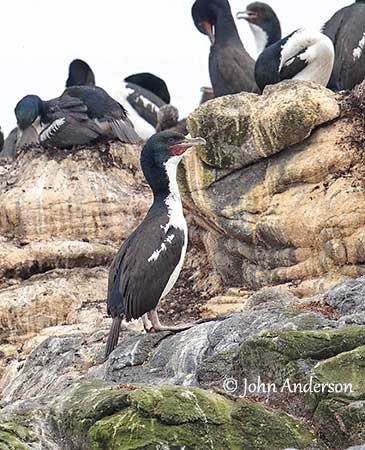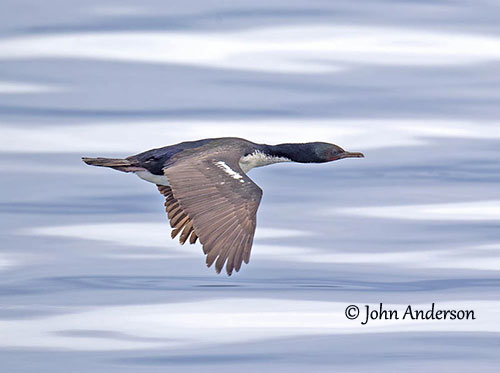
Fr: Cormoran de Foveaux
Ang: Foveaux Shag
Nd: Foveauxaalscholver
Sd: foveauxskarv
Photographer:
John Anderson
John Anderson Photo Galleries
Text by Nicole Bouglouan
Sources:
Wikipedia, the free encyclopaedia
New species of shag discovered in Southland and Otago
Page family Phalacrocoracidae
Summary cards
Foveaux Shag
Leucocarbo stewarti
Suliformes Order – Phalacrocoracidae Family
INTRODUCTION:
The Foveaux Shag was until recently classified with the Otago Shag in a single species, but today, it is a full species in the genus Leucocarbo. It is endemic to Stewart Island and Foveaux Strait in New Zealand, giving the bird its name.
This dimorphic species has two plumages, with pied individuals and others dark overall. However, both morphs can breed together. They form fairly large colonies reused in several following years. They are rarely seen far out to sea, preferring the coastal waters for foraging.
The Foveaux Shag has small population and the species is currently vulnerable to extinction.
DESCRIPTION OF THE BIRD:
Biometrics:
Length: 68 cm
Weight: 1800-2500 g
The Foveaux Shag is slightly smaller than Otago Shag. Both species contain pied and bronze morph types.
The Foveaux Shag differs by colour and shape of head ornaments. It has dark orange papillae scattered through a narrow area at base of upper mandible. The gular pouch is bright to dark orange. These ornaments become smaller and duller after the breeding season.
The pale bill is flesh-coloured. The eyes are brown, surrounded by blue bare skin. Legs and webbed feet are pale pinkish.

The pied birds have dark upperparts, wings and tail. There is a white patch on scapulars, forming a pale wingbar on closed wings. The underparts are white.
The dark or bronze morph has dark plumage overall, but the head pattern is similar.
Both morphs have blue and green gloss on their dark feathers, especially on head, hindneck and lower back.
Male and female are similar.
The juvenile resembles young Otago Shag and has two morphs.
RANGE:
The Foveaux Shag is restricted to Stewart Island and Foveaux Strait in New Zealand.
HABITAT:
The Foveaux Shag breeds on offshore islands and the colonies are established on sea cliffs. Outside breeding season, they remain in coastal waters.
CALLS AND SONGS:
The Foveaux Shag is more vocal during the breeding season and at colonies. Various sounds such as croaking, groaning and gargling calls can be heard.
BEHAVIOUR IN THE WILD:
Like most Phalacrocoracidae, the Foveaux Shag feeds mainly on fish, but it also consumes marine invertebrates such as crustaceans, shrimps, crabs and molluscs.
They may forage in small groups. It dives from the surface and pursues the prey underwater. The prey is caught with the bill. While surfacing, the cormorant flips the fish into the air in order to turn it and swallows it head first.
It usually forages in coastal waters less than 30 metres deep and can be seen also in harbours. They rarely venture far out to sea.
The Foveaux Shag breeds in colonies established on sea cliffs where the two morphs are present. They are monogamous.
The species is probably sedentary within its restricted range.
The flight is direct and powerful.

REPRODUCTION OF THIS SPECIES:
The breeding season starts in September. The colonies are established on sea cliffs on offshore islands. They are fairly large and can be seen easily.
The nest is a raised cup made on the ground with seaweeds, sticks and grass, held together with guano. The nest is usually reused in several following seasons and new materials are added every year.
The nesting behaviour is probably similar to that of the Otago Shag. The clutch contains 1-3 eggs and both adults incubate during 23-35 days. The chicks are fed by regurgitation by their parents.
PROTECTION / THREATS / STATUS:
The Foveaux Shags have been less affected by humans because they nest on inaccessible offshore islands.
The population is estimated at less than 2,500 individuals. However, it is suspected to be currently stable. But the species is vulnerable to extinction due to the small numbers. Conservation efforts are required.